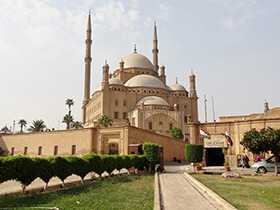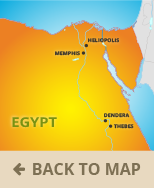Islamic Period and Modern Times Monuments
- Neolithic Period: 4500-3000 BCE
- Early Dynastic: 3000-2650 BCE
- Old Kingdom: 2650-2150 BCE
- 1st Intermediate Period: 2150-2040 BCE
- Middle Kingdom: 2040-1640 BCE
- 2nd Intermediate Period: 1640-1550 BCE
- New Kingdom: 1550-1070 BCE
- 3rd Intermediate Period: 1070-712 BCE
- Saite and Late Periods: 712-332 BCE
- Greco-Roman Period: 332 BCE-642 CE
- Coptic Period: 395-642 CE
- Islamic Period and Modern Times: 642 CE-Today
- Neolithic Period: 4500-3000 BCE
- Early Dynastic: 3000-2650 BCE
- Old Kingdom: 2650-2150 BCE
- 1st Intermediate Period: 2150-2040 BCE
- Middle Kingdom: 2040-1640 BCE
- 2nd Intermediate Period: 1640-1550 BCE
- New Kingdom: 1550-1070 BCE
- 3rd Intermediate Period: 1070-712 BCE
- Saite and Late Periods: 712-332 BCE
- Greco-Roman Period: 332 BCE-642 CE
- Coptic Period: 395-642 CE
- Islamic Period and Modern Times: 642 CE-Today
Muhammad Ali Mosque
Begun 1830
Muhammad Ali Pasha – whom many consider the father of modern Egypt for his numerous, enduring, modern reforms – commissioned this mosque to be built in 1830 in memory of his son. Construction took over twenty years. It was intended originally to serve as the national mosque for a newly quasi-independent state of Egypt. It is today one of the first buildings visible when approaching Cairo from any direction.
The mosque represents in some ways Muhammad Ali’s rebuke of the several centuries of Mamluk rulers and cultural dominance that preceded him in Egypt. Ali, who was an Ottoman army commander of Albanian origin, adopted the architectural style of the country’s former imperial overlords when he chose the design of the mosque, something the Mamluks avoided. The architect is said to have used the Sultan Ahmed Mosque in Istanbul as a model for his design. Ali ordered the mosque to be built on the site of Mamluk buildings he had razed inside the then-700-year-old Citadel of Saladin overlooking Cairo. (Ali later invited the remaining Mamluk leadership to the Citadel under the guise of a celebration, and then had them all slaughtered on arrival.)
In 1899, the mosque began to show serious signs of disrepair, but a full renovation did not begin until 1931, and did not finish until 1939, during the reign of Muhammad Ali’s ninth and penultimate successor, King Faoruk I.

https://archnet.org/sites/1528/publications/3046
http://www.discoverislamicart.org/database_item.php?id=monument;isl;eg;mon01;21;en

